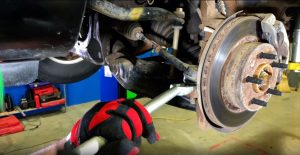Modern cars have seen big changes in technology. The suction control valve is key in making cars more fuel-efficient and cleaner.
These valves have a long history. They help control fuel pressure and make engines run better. As car tech keeps getting better, these parts are more important than ever.
They show how far car tech has come. They help make cars run better and cleaner.
Key Takeaways
- Suction control valves are key for better fuel use and less pollution.
- They help manage fuel pressure and engine performance.
- The growth of these valves is a big part of car tech progress.
- Modern cars get a lot of benefits from new valve tech.
- The history of suction control valves shows their big role.
Understanding the Suction Control Valve in Modern Vehicles
In today’s cars, the suction control valve is key. It’s a must-have for diesel engines, helping with fuel flow. The SCV, short for suction control valve, controls how much fuel goes to the high-pressure pump.
Definition and Core Functions
The suction control valve manages fuel for the high-pressure pump. It keeps fuel pressure right, making the engine run well. By adjusting fuel intake, it helps the engine perform at its best.
Critical Role in Fuel Delivery Systems
The SCV is vital for fuel pressure and engine efficiency. For more on fixing SCV problems in diesel engines, check out DENSO’s guide on SCV diagnosis.
| Key Function | Description |
| Fuel Pressure Regulation | Controls the amount of fuel drawn into the high-pressure fuel pump |
| Engine Performance Optimization | Ensures optimal engine performance by maintaining desired fuel pressure |
| Efficiency Enhancement | Enhances engine efficiency by adjusting fuel intake according to engine needs |
Historical Development of Fuel Pressure Regulation
The history of fuel pressure regulation is filled with innovation. It started with simple mechanical systems and moved to advanced electronic controls. This change has greatly improved engine performance, efficiency, and cut down emissions.
Pre-Electronic Fuel Regulation Methods
At first, fuel pressure was managed by mechanical systems like carburetors and fuel pumps. These systems were not very efficient and didn’t control fuel pressure well. This led to poor engine performance and more emissions.
- Mechanical fuel pumps provided basic pressure regulation.
- Carburetors mixed air and fuel but were limited in their ability to precisely control fuel pressure.
First Generation Electronic Suction Control Valves
The first electronic suction control valves were a big step forward. They offered better control over fuel pressure. This made engines run better and more efficiently.
Electronic suction control valves could adjust fuel pressure based on engine conditions.
Transition to Modern Precision Systems
Now, we have even better systems for fuel pressure regulation. These use advanced electronics and sensors for precise control. This has made engines perform even better, use less fuel, and reduce emissions.
Modern systems have greatly improved engine performance, fuel efficiency, and emissions reduction.
- Advanced sensors monitor engine conditions in real-time.
- Electronic controls adjust fuel pressure with high precision.
- Improved fuel efficiency and reduced emissions are notable benefits.
How Suction Control Valves Revolutionized Diesel Engines
Suction control valves have changed diesel engine performance and efficiency. They do this by controlling fuel flow, which is key for the engine to work well.
Mechanical Operation Principles
The way suction control valves work is by managing fuel pressure in diesel engines. They control how much fuel goes into the engine. This makes the engine run better and more reliably.
Electronic Control Integration
Adding electronic controls to suction control valves has made diesel engines better. Electronic control units (ECUs) help the SCV work right, adjusting to the engine’s needs. This has made engines more fuel-efficient and cleaner.
Impact on Common Rail Diesel Systems
Suction control valves have greatly helped common rail diesel systems. They control fuel pressure well, making these systems more efficient and powerful. This means diesel engines are stronger and better for the environment.
The Anatomy of a Modern Suction Control Valve
In the world of cars, suction control valves are key for better engine performance. They help control fuel flow well. This makes the car’s fuel system more efficient and reliable.
Component Structure and Materials
A modern suction control valve has many parts, all made from strong materials. The body is usually made from strong alloys. The inside parts might be ceramics or other materials that don’t wear out easily.
| Component | Material | Function |
| Valve Body | High-strength Alloy | Provides structural integrity |
| Internal Components | Ceramics | Enhances wear resistance |
| Seals | Advanced Polymers | Ensures leak-tight operation |
Electromagnetic Actuation Systems
The way a modern suction control valve works is thanks to an electromagnetic system. This system lets the valve open and close precisely. It adjusts fuel flow as the engine needs it.
This system has a coil, armature, and control circuitry. When electricity is sent, the coil makes a magnetic field. This field moves the armature, controlling the valve’s position.
Technological Advancements in Suction Control Valve Design
Manufacturing has changed a lot, making suction control valves better. These changes come from new tech in many areas.
Precision Manufacturing Improvements
Precision making has helped a lot in valve design. Today’s methods let us make parts that work better and last longer. Computer-aided design (CAD) and computer numerical control (CNC) machining are key to these advances.
Material Science Innovations
New materials and ways to make them have helped valves too. Now, valves last longer and don’t rust as much. Advanced materials and coatings make them work better and last longer.
Miniaturization and Efficiency Gains
Valves are getting smaller, which is good for tight engine spaces. These smaller valves save space and help engines use less fuel and make less pollution. They fit in tight spots, making engines more flexible.
Together, better making, new materials, and smaller sizes have made valves better. This helps engines run smoother and more efficiently.
Suction Control Valve Performance in Australian Driving Conditions
Australia’s driving conditions are tough for suction control valves. They need to work well in many different places. From hot deserts to wet coasts, these parts must keep working.
Adaptation to Extreme Temperature Variations
Suction control valves face big temperature changes in Australia. It gets very hot during the day and very cold at night. This can make the valve work less well.
But, new valves are made to handle these changes. They use special materials and coatings. This helps them keep delivering fuel well.
Dust and Particulate Challenges in Outback Driving
The outback is full of dust and small particles. This can block the fuel system of suction control valves. It makes them less reliable.
Now, valves have better filters and seals. These stop dust from getting in. This keeps the valve working well.
Coastal Region Corrosion Considerations
Coastal areas are close to saltwater. This can make metal parts of valves rust faster. It can cause them to fail early.
So, valves are made with materials that don’t rust easily. They also have special coatings. This helps them last longer in salty air.
| Environmental Factor | Challenge to SCV | Design Adaptation |
| Extreme Temperatures | Thermal Stress | Specialized Materials and Coatings |
| Dust and Particulates | Clogging and Wear | Advanced Filtration and Seals |
| Coastal Corrosion | Material Degradation | Corrosion-Resistant Materials and Coatings |
Diagnosing Failing Suction Control Valves
Knowing the signs of SCV failure is key. A bad Suction Control Valve can hurt your engine’s performance and fuel use. It can even cause more damage if not fixed.
Common Symptoms and Warning Signs
Spotting SCV failure signs is the first step. Look out for:
- Decreased engine performance
- Reduced fuel efficiency
- Erratic engine behavior
- Illuminated check engine light
These signs can also mean other problems. So, it’s important to use tools to confirm SCV failure.
Diagnostic Tools and Procedures
Technicians use special tools to find SCV failure. These include:
- Multimeters for electrical circuit testing
- Scan tools for reading engine control unit (ECU) error codes
- Pressure test kits for assessing fuel system pressure
For more info, check out forums like Vectra-C forum. There, users talk about SCV diagnosis.
Differentiating from Other Fuel System Issues
It’s important to tell SCV failure from other fuel system problems. This means:
- Doing thorough visual checks
- Testing SCV with diagnostic tools
- Looking at ECU error codes for fuel system issues
By doing these steps, techs can find SCV failure and suggest fixes.
Maintenance and Replacement of Suction Control Valves
Keeping Suction Control Valves (SCVs) in good shape is key for your car’s fuel system. Regular checks and timely replacements are vital. They help avoid fuel system problems and keep your engine running well.
Preventative Maintenance Strategies
Preventive care is important for SCVs. Look for wear signs, clean the valve, and update software if needed. Following the maker’s maintenance guide helps keep your car running smoothly.
Replacement Procedures and Best Practices
Replacing an SCV needs careful steps. First, empty the fuel system. Then, remove the old valve and put in a new one that fits right. Make sure electrical connections are good and the system is bled right after.
Cost Considerations for Australian Vehicle Owners
The cost to replace an SCV varies by car type and labor. In Australia, it’s about $200 to $500 for parts and work. Always get a quote from a certified mechanic.
| Vehicle Type | Average Cost of SCV Replacement | Labor Cost |
| Passenger Vehicles | $250-$400 | $100-$200 |
| Commercial Vehicles | $300-$500 | $150-$250 |
Knowing how to care for SCVs helps keep your car running well. It saves you from expensive fixes later on.
The Environmental Impact of Advanced Suction Control Valve Technology
Modern vehicles use advanced suction control valves. This technology helps reduce environmental harm. It does this by cutting down emissions and making vehicles more fuel-efficient.
Emissions Reduction Capabilities
Advanced suction control valves are key in lowering vehicle emissions. They control fuel delivery well. This leads to cleaner combustion and less harmful emissions.
Some benefits include:
- Lower levels of nitrogen oxides (NOx)
- Reduced particulate matter (PM) emissions
- Minimized hydrocarbon (HC) emissions
This makes vehicles better for the environment and meets strict emission rules.
Fuel Efficiency Improvements
Advanced suction control valves also boost fuel efficiency. They make sure engines run at their best. This brings several advantages.
- Enhanced fuel economy
- Reduced fuel consumption
- Lower operating costs for vehicle owners
With fuel costs going up and more people caring about the environment, this is a big plus.
OEM vs. Aftermarket Suction Control Valves in the Australian Market
The Australian car market is tricky when picking between OEM and aftermarket Suction Control Valves (SCVs). This choice greatly affects how well your car runs and its warranty.
When looking at SCVs, two key things matter: how well they work and how long they last. Also, the warranty they come with is important.
Quality and Performance Comparisons
OEM SCVs are made to fit your car perfectly and work best. Aftermarket SCVs might be cheaper but can be of different quality.
- OEM SCVs: Guaranteed compatibility and performance
- Aftermarket SCVs: Variable quality, possible lower performance
Warranty and Longevity Considerations
OEM SCVs usually have a warranty from the maker. This gives car owners peace of mind. Aftermarket SCVs might have shorter or no warranties, which could cost more in the long run.
In summary, while aftermarket SCVs might save money upfront, OEM SCVs are better. They offer top quality, performance, and warranty, making them a good choice for many in Australia.
Suction Control Valve Adaptations for Alternative Fuel Vehicles
Suction control valves are being updated for alternative fuel cars. This includes biodiesel and hybrid cars. It’s key as cars move towards being more green and friendly to the planet.
Biodiesel Compatibility Modifications
Biodiesel needs special suction control valves for the best performance. Biodiesel is different from regular diesel because it’s more slippery but might have less energy. SCV adaptations for biodiesel compatibility mean changing materials and designs to work with these differences.
| Modification | Purpose | Benefit |
| Material changes | To resist corrosion from biodiesel | Enhanced durability |
| Design adjustments | To accommodate different fuel properties | Improved performance |
Applications in Hybrid Powertrains
In hybrid cars, suction control valves are key for fuel management. SCV adaptations for hybrid powertrains aim to save fuel and cut down on emissions. They use smart controls and precise valve actions to meet the hybrid system’s needs.
The Road Ahead: Future Innovations in Fuel Delivery Control
The car world is always changing, thanks to new tech and the push for greener cars. New ideas in fuel delivery control will be key to this change. We’re talking about better making, new materials, and smarter electronic systems.
We’re looking forward to fuel systems that work better, use less fuel, and pollute less. Cars will use advanced sensors and AI to adjust fuel use on the fly. This will help them perform well in different conditions and with different fuels.
Future fuel systems might also work with new, cleaner fuels. This is part of the shift to cleaner energy. The next big step in fuel delivery will meet tough new rules on pollution. At the same time, they’ll keep up with what drivers want from their cars.








